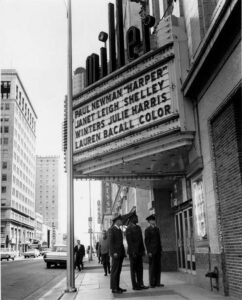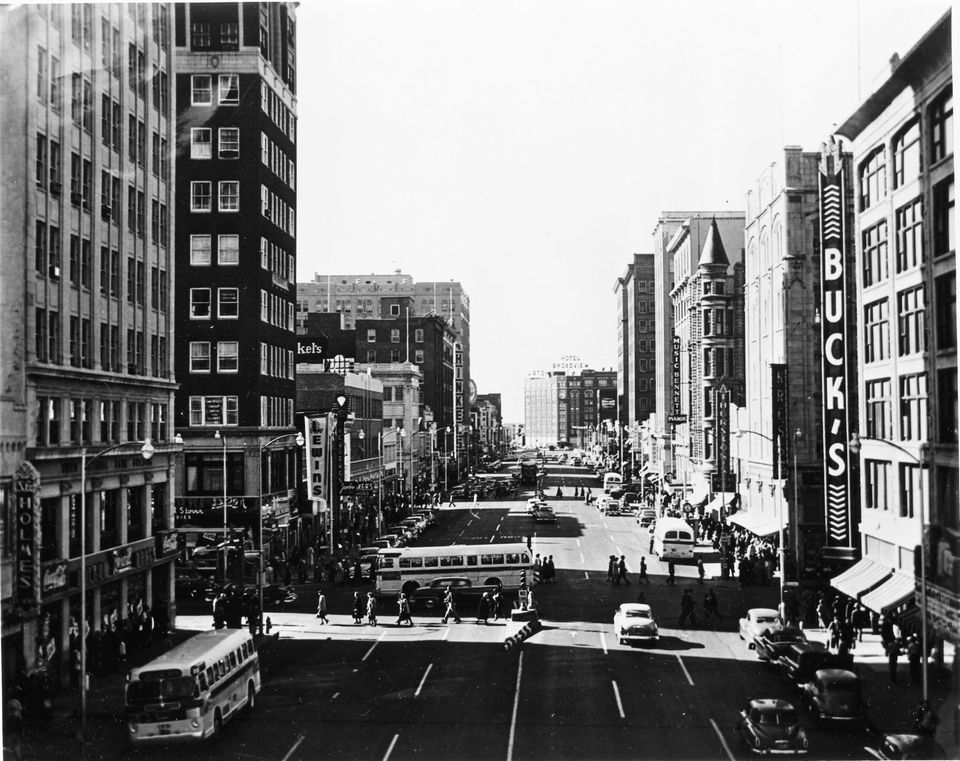Large shopping centers came to Wichita in the 1950s, but even then, they could not compete with downtown. Buses quickly took people from all points on the compass to the large, compacted shopping district. There was so much pedestrian traffic that the stoplight at the Allis Hotel, in the 200 block of south Broadway, had a “scramble” feature that allowed diagonal crossing. The following interviews give a flavor of that time. They were collected as part of the Wichita Old Neighborhood Project, in conjunction with Wichita State University library’s Special Collections section. The neighborhood of each speaker is given after their name.
Doug Ballard (North Central)
“I was a YMCA kid; used to walk around downtown amazingly young. I remember my mom telling me that when I got to be nine, I could ride the bus downtown on Saturday by myself. So, I would catch the bus at Ninth and Volutsia.
“Between my tumbling class and my swim class, there was some time. I was interested in shortwave radio, and there were a number of pawnshops downtown. I would go from pawnshop to pawnshop. Also Mr. Moler had some used shortwave radios in his camera shop there on Broadway. The old Y was at First and Emporia. My folks knew that I was doing a little walking and they weren’t worried. What has happened to our culture?
“One Saturday—I was probably about 10 or 11—my dad told me when I was getting ready to go to the Y, ‘Don’t catch the bus coming home. I will pick you up. We are going to go to Hillsboro for the weekend.’ The following Saturday when I got on the bus to go downtown, the bus driver said, ‘Hey, where were you last Saturday?’ I told him, and he said, ‘If you’re not going to catch the bus home, you need to tell me.’ I didn’t know his name; he didn’t know me. But when I was on his bus, he was in charge of me.”
The city bus driver was typical of the concern shown for the young in the 1950s. Wichita was a safe place.
Kenny Potter (East Mt. Vernon)
“When we were 11 or 12, we started taking the bus downtown. We went to the arcades, the White Way (a pool hall) and watched them play pool. They would let you stay for a while. The White Way didn’t last much past then. And we went to all the movie theaters: the Miller, the Crawford, the State. We saw cowboy serials. It wasn’t a weekly thing.”
Jan Manlove (Schweiter East)
“I would go with my friend downtown on the bus to shop, and I went Christmas shopping downtown with my parents. When we took the bus, we would get off in front of Woolworth. We would always hit Innes’ candy counter. The Model was down there; (and) Kress, but I didn’t go in there a lot. Parents didn’t worry about you. It was cheap to ride the bus.”
Brad Rine (Fabrique)
“Downtown was the common area, because there was nothing else to go to. We took the bus. Our drop-off point was the VA Hospital. We didn’t have air conditioning in the house. Mom would take us down to the Orpheum or the Miller and drop us off for a double feature. She would give us the money to take the bus home, but we never had the money—spent it on popcorn or another candy. We’d have to walk home. Often we would go to Jenkins Music and listen to records. Jenkins was one of the few places that welcomed teenagers. They were always the first ones out with the new records.”
How many kids back then chose treats over bus fare?
Jerry Brazil (Courtland)

The Miller Theater at 115 N. Broadway was one of many attractions downtown. Considered by some the grandest theater in Kansas, it was demolished in 1972.
“I was a pawnbroker for 10 years at Wolkow Loans, 424 E. Douglas, starting my freshman year in high school through all my years of college. My dad belonged to The National Conference of Christians and Jews, and through that, he met Max Wolkow. Max and dad would go fishing. I started cutting Max’s lawn, and when I got to be 14 and could get a Social Security card, he asked me to come and work in the store, unpacking shipments of luggage and running errands to the post office and keeping the watches polished up and wound. I started working there during the summer and through the year, working on Saturdays. I would catch the bus to work and ride it home.
“I learned a lot about dealing with people. Max was a very honest man. I know pawnbrokers have a bad reputation. He was born in the Ukraine. His father was a rabbi. Max was studying to be a rabbi. Around 1890, the Czar started drafting Jews into the Army. Max had a brother who had already immigrated to Wichita. He sent him a ticket for passage, and he went to work in his brother’s store, eventually establishing Wolkow Loan. The main pawnshops were all downtown then—Rosen Brothers, Leben Brothers, McFarland’s. Wichita Loan was on the corner of Emporia and Douglas. This was during World War II. Pawnshops took the place of signature loans. There were no credit cards. Blue-collar workers could not get bank loans. Also on the 400 block was the White Way pool hall. There was the Corral Theater next door. In the summer, the smell of the concession stand that sold hamburgers in the White Way, as well as the stale smoke and stale beer and unwashed bodies, was terrible.
“Max always made an effort to see that people got their items back. They had a lot of regular customers; people who just quite couldn’t make it to payday. They would pawn their camera, their watch. If they were real regular customers, Max would give them a call and say ‘You’re behind on your payments. If you come in, we can work something out,’ because he wanted return customers. That’s what he prided himself on. I think I got sixty cents an hour to start. Later, I got a five percent commission on sales sliding up to seven or eight percent if I went over $100 a day. It was fun. There was another guy that worked there and sometimes Max would designate an item that wasn’t moving and say ‘This is the spif (slang for bonus). Anybody who sells it, gets to keep the money.’”
How many of us bought the spif?
Pat O’Connor hopes to conduct 100 interviews for the Wichita Old Neighborhood Project. He can be reached at wichlitsoc@gmail.com or (316) 832-0309.








